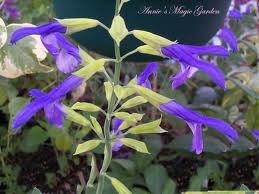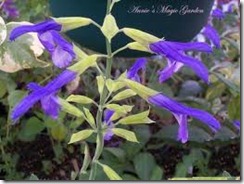Prized for its sturdy blue flowers, Salvia Mexicana makes a great addition to a southwestern garden, or as a late-season show stopper for cooler environments. A hearty, tough plant, salvia tolerates heat and drought and can be easily propagated through clippings. Birds and butterflies love it as well, making it a great choice for gardeners wishing to attract wildlife. As with any plant, it must be properly cared for to flourish, especially in climates that are somewhat hotter or cooler.
Characteristics
-
Salvia Mexicana, or Mexican sage as it’s also called, belongs to a category of deciduous herbaceous salvias that all (when planted in native climates) die back in the winter and come back again in the spring. It grows especially tall, though, making it distinctive amongst this group–in especially warm climates, where it can grow as tall as 12 feet, although 5 feet is a more likely average height in most places. A mature S. Mexicana plant produces deep blue flowers with delicate white veining that bloom from late spring to fall. The flowers grow in opposing rows along the stem, up to the top of the plant.
Where Salvia Mexicana Grows
-
A native of central Mexico, S. Mexicana prefers very warm climates. In the wild, it flourishes on the edges of forests and in fields, but it also makes for a nice shrub in the garden. Although it can withstand high heat, it thrives when planted in locations that receive partial shade in the midday. It tolerates soils with high clay or lime content as long as they still provide adequate drainage.
Especially Warm or Cold Climates
-
Although exceptionally drought-tolerant, salvias do need to be watered sometimes, particularly when planted in especially hot areas or during long, dry summers. Usually, once a week will suffice. They are somewhat frost-resistant but will die back when temperatures regularly fall within 20 degrees F. In warmer climates, though, they will usually survive the winter and might even retain foliage all year. To increase the chance of winter survival, it’s best to delay pruning until the spring. In especially cold climates, they do not survive the winter chill. In these places, salvia is often grown as an annual, meaning that new salvias are planted each year.
Salvia Mexicana in the Garden
-
Because of its height and its contained shape, Salvia Mexicana can be paired with smaller plants, providing useful shade. Deer hate it and will stay well away, making it an especially hearty contender in more rural areas. It attracts hummingbirds and all kinds of butterflies, as well, so it makes a great addition for a butterfly garden.
Propagation
-
Like its relative, mint, Salvia Mexicana can withstand clipping and can be propagated easily from cuttings. Ideally, these cuttings should be taken from the tips of the plant during the summer months. Roots will generate when the clippings are left with their ends standing in a glass of water. Then they can be easily transplanted into the garden. Additionally, salvias can be grown to maturity quite readily from seed, although seed packages can be difficult to find.


Deprecated: strpos(): Passing null to parameter #1 ($haystack) of type string is deprecated in /home/agriviek8Qv/agriviet.net/public_html/wp-includes/comment-template.php on line 2522